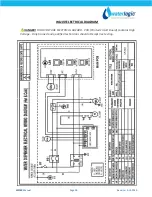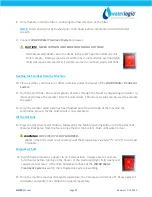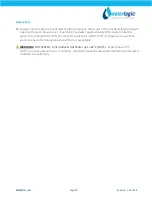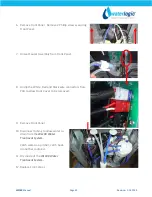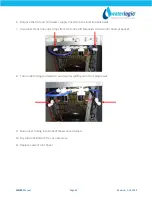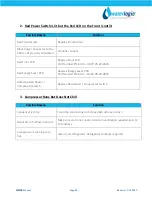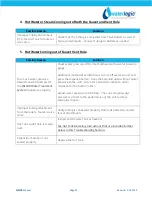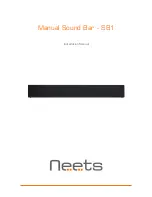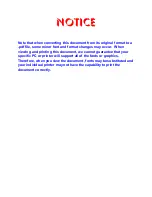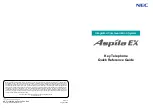
WL100
Manual Page 38 Revision: 1‐14‐2019
Always ensure proper ventilation and use proper personal protective equipment such as gloves
and eye protection when using chemicals. Refer to Material Safety Data Sheet for specific
requirements of each chemical product. Take all necessary precautions to prevent sanitizer
from contacting eyes, clothing, and any other surfaces in could damage (carpets).
2.
Put 5 Millimeter (1 Teaspoon) of sanitizer per directions or use Bleach Solution (5 Millimeter = 1
Teaspoon = 1/6 ounces = ½ cap full) of household bleach (Sodium Hypochlorite 5 ‐ 10%
Concentration) in the Sanitizing Cartridge. Always ensure sanitizer is compatible with stainless
steel and acetyl plastic.
3.
Connect Sanitizing Cartridge to inlet water supply and connect to Inlet Bulkhead Fitting on back of
unit. Turn on water supply.
4.
Connect power to the
WL100 Water Treatment System
. DO NOT TURN ON RED
HEATER – COMPRESSOR SWITCH AT THIS TIME.
Red Compressor/Heater Switch
must be in the O=OFF position.
Fill the Cold Circuit with Sanitizer
5.
Depress the Main Dispensing Button on the Front Control Panel until cold water/sanitizing
solution comes out the faucet.
NOTE:
Container and drain basin will be required to catch the
water from the faucet.
WARNING!
Use Personal Protective Equipment. Gloves and Eye Protection Required. The first
8 or 11 Liters (2 or 3 gallons) of water will contain concentrated sanitizer. Use extreme care!
6.
Turn off water supply and remove Sanitizing Cartridge from inlet water supply. Reconnect water
supply to Inlet Bulkhead Fitting.
Flush Filters
CAUTION!
FILTER FLUSH REQUIRED.
WL100 Water Treatment Systems
are not supplied with filters. Filters should be configured to
optimize your system. Filters need to be configured and specified to do the job given the local
water conditions, usage, maintenance schedule, and placement restrictions.
In order for our filters to perform as represented and to provide the best quality water
possible, it is essential that filters be replaced periodically. The frequency of filter changes
depends upon your water quality and your water usage. For example, if there is a lot of
sediment and/or particles in your water, then you will have to change your filters more
frequently than a location with little to no sediment. Be sure to replace your filters whenever
you notice a decline in the performance, whether it is a drop in flow rate and/or pressure or an
unusual taste in the water.
7.
Flush thoroughly per filter manufacturers’ recommendation with fresh water to drain.













